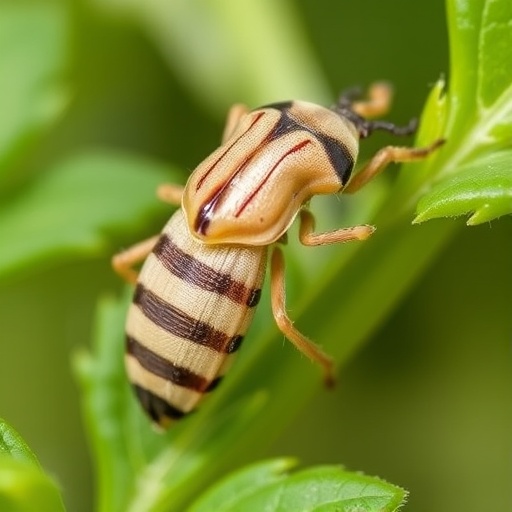In the relentless global pursuit of sustainable agriculture and eco-friendly pest management, recent research has unveiled a promising player poised to transform the biological control landscape. A new isolate of Steinernema abbasi, a species of entomopathogenic nematode, has been rigorously characterized and shown to exhibit remarkable biocontrol efficacy against two notorious agricultural pests: Spodoptera litura, commonly known as the tobacco cutworm, and Mythimna separata, or the oriental armyworm. This breakthrough encapsulates an innovative stride towards integrated pest management strategies by harnessing the natural antagonistic relationships occurring in soil ecosystems.
The newly identified nematode isolate was subjected to an in-depth morphological and molecular characterization to ascertain its identity and possible novelty compared to previously documented strains of S. abbasi. Morphological traits such as infective juvenile dimensions, body shape, and esophageal region specifics were meticulously measured and compared, while molecular analyses focused on sequencing particular ribosomal DNA regions. These combined approaches confirmed the isolate’s affiliation with Steinernema abbasi but highlighted distinctive genetic markers indicative of its unique biocontrol potential.
Understanding the biology and lifecycle of entomopathogenic nematodes is pivotal to maximizing their utilization. Steinernema species are renowned for their symbiotic relationship with bacteria belonging to the genus Xenorhabdus, which they release upon infecting insect hosts. The bacteria produce toxins that swiftly incapacitate the host, paving the way for nematode reproduction inside the cadaver, eventually perpetuating their lifecycle. This covert infection mechanism makes S. abbasi an invaluable ally against agriculturally detrimental lepidopteran larvae.
The tobacco cutworm, Spodoptera litura, inflicts substantial economic damage globally, affecting a broad spectrum of crops such as cotton, soybean, and various vegetables. Similarly, Mythimna separata is notorious for devastating cereal crops across Asia, posing serious threats to food security. Conventional chemical control methods often entail pesticide resistance development, environmental contamination, and non-target organism harm, underscoring the urgent need for viable biological alternatives. This newly isolated S. abbasi strain’s pathogenicity assays demonstrated a high mortality rate in both pest species, positioning it as a formidable candidate for biocontrol.
Laboratory bioassays involved treating larvae of both S. litura and M. separata with varying concentrations of infective juveniles (IJs) from the nematode isolate. Mortality outcomes exhibited a dose-dependent response, with substantial larval death recorded at relatively low nematode exposure levels. Notably, the infective juveniles showed rapid host-seeking behavior and robust penetration efficiency, critical attributes for effective field application. Furthermore, no adverse effects on non-target beneficial insects or soil microorganisms were observed in preliminary studies, emphasizing ecological safety.
Beyond immediate pest mortality, the nematode’s ability to persist in soil environments and establish enduring populations was investigated. The isolate displayed notable resilience under varying soil moisture and temperature ranges, which suggests potential for sustained control across diverse agroecological zones. This environmental adaptability could enable deployment in regions where fluctuating climatic conditions hinder the utility of other biocontrol agents, broadening the scope of integrated pest management.
Advancements in molecular techniques allowed researchers to delve deeper into the isolate’s symbiotic bacterial profile. Sequencing and phylogenetic analysis of the Xenorhabdus bacteria associated with this S. abbasi strain revealed unique secondary metabolite gene clusters. These genetic features are likely responsible for the potent insecticidal activity observed, hinting at previously untapped biochemical pathways. Unlocking such microbial chemical arsenals not only enhances understanding of host-pathogen interactions but also lays groundwork for biopesticide development.
Field trials conducted in controlled crop environments substantiated laboratory findings, where plots treated with the nematode isolate exhibited significantly reduced pest infestations compared to untreated controls. Crop damage assessments demonstrated preservation of leaf area and improved overall plant vigor. Importantly, these naturally derived nematode applications showed no phytotoxic effects or environmental detriments, underscoring the method’s sustainability and farmer acceptability.
This research addresses critical challenges hindering entomopathogenic nematode commercialization, including production scalability, delivery mechanisms, and field persistence. Optimization efforts reported include formulating nematode-containing bio-products capable of maintaining viability during storage and transportation. The development of aqueous suspensions and granular formulations optimized for easy application further enhance user adoption potential in diverse farming systems.
The success of the novel S. abbasi isolate also provides insights into evolutionary adaptation within nematode populations subjected to selective pressures in pest-rich environments. Its enhanced virulence and stress tolerance may stem from genetic exchanges or local environmental adaptation, offering a model system for studying nematode-pathogen evolution and co-adaptive dynamics.
Importantly, the integration of this entomopathogenic nematode into existing pest management strategies could reduce reliance on synthetic pesticides, diminishing environmental contamination and human health risks. Widespread adoption could lead to restored biodiversity in agroecosystems, bolstered populations of natural enemies, and improved ecosystem resilience, essential components for sustainable agriculture.
Looking forward, researchers advocate for the expansive screening of native nematode populations to uncover additional isolates with superior biocontrol attributes. Collaborative efforts between molecular biologists, entomologists, and agronomists are poised to refine delivery systems, tailor nematode formulations, and evaluate long-term ecological impacts under diverse agroclimatic scenarios.
The promising findings concerning this Steinernema abbasi isolate underscore the critical role of biodiversity explorations in uncovering practical solutions to pressing agricultural challenges. Employing such natural, environmentally harmonious tools aligns with global goals for pesticide reduction and sustainable food production, offering a beacon of hope in combating resilient crop pests.
Ultimately, this study exemplifies how bridging classical taxonomy with contemporary molecular biology and applied field research can yield impactful innovations. As the agricultural sector intensifies efforts to reconcile productivity with environmental stewardship, biological control agents like the newly characterized S. abbasi isolate represent a vital arsenal in the quest for agroecological balance and global food security.
Subject of Research: Biological characterization and pest control efficacy of a newly isolated Steinernema abbasi nematode against key lepidopteran pests affecting agriculture.
Article Title: Characterization and Biocontrol Efficacy of a New Isolate of Steinernema abbasi (Elawad Ahmad & Reid, 1997) Against Spodoptera litura (Fabricius) and Mythimna separata (Walker).
Article References:
Mallikarjun, G., Keshari, N., Mahboob, M. et al. Characterization and Biocontrol Efficacy of a New Isolate of Steinernema abbasi (Elawad Ahmad & Reid, 1997) Against Spodoptera litura (Fabricius) and Mythimna separata (Walker). Acta Parasit. 70, 205 (2025). https://doi.org/10.1007/s11686-025-01143-7
Image Credits: AI Generated




